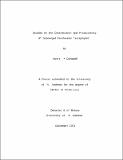Files in this item
Studies on the distribution and productivity of submerged freshwater macrophytes
Item metadata
| dc.contributor.advisor | Spence, David Hugh Neven | |
| dc.contributor.author | Campbell, Robert M. | |
| dc.coverage.spatial | 1 v. | en_US |
| dc.date.accessioned | 2018-06-18T14:31:54Z | |
| dc.date.available | 2018-06-18T14:31:54Z | |
| dc.date.issued | 1971 | |
| dc.identifier.uri | https://hdl.handle.net/10023/14209 | |
| dc.description.abstract | This thesis has attempted to describe some of the distribution patterns of submerged aquatic macrophytes in Scottish lochs. Effort has been directed towards prescribing a precise lochs. Effort has been directed towards prescribing a precise meaning to productivity with respect to these plants to its measurement, and to investigating presible influencing factors. Using aqualung diving techniques, biomass estimates have been made in several lochs. These results have been viewed in two ways, (a) qualitatively and (b) quantitatively. Qualitative It has been that, in any one loch, there is a zonation of species with depth of water. Generally, Littorella uniflora/Lobelia dortmanna communities were dominant in the shallower water (up to one metre), while otamogeton species occupied the deeper areas (up to seven metres). Of the substrate variables investigated, no parameters have been shown to be causally correlated with the distribution of such factors was complicated by a high degree of variance in the biomass estimates of vegetation on fairly uniform substrates. Distribution patterns of species between lochs have also been noted. The members of the Characeas were only found in the limestone lochs of high pH and alkalinity, while Lobelia dortmanna and Isoetes lacustris were confined to the more base-poor waters. Litorella uniflora was found in all the Iochs studied. Only two species of broad-leaved, sub-merged pondwecds were found in the limestone lochs but, while these were not restricted to such habitats, other species of the genus Potamogeton were. No one factor has been shown to underlie this distribution pattern though, in the case of the Characeae, it would appear that the high alkalinity of the water is related to the predominance of some members of this family in the limestone lochs, where they can produce their calcium carbonate exoskeletons. It is also possible that the low concentration of phosphorus in the limestone waters, shown by others to be a maximum factor in the growth of the Characase, is also important, while the general low nutrient concentrations may exclude other species from these areas. | en_US |
| dc.language.iso | en | en_US |
| dc.publisher | University of St Andrews | |
| dc.subject.lcc | QK565.C2 | en |
| dc.subject.lcsh | Algae—Physiology | en |
| dc.title | Studies on the distribution and productivity of submerged freshwater macrophytes | en_US |
| dc.type | Thesis | en_US |
| dc.contributor.sponsor | Natural Environment Research Council (NERC) | en_US |
| dc.type.qualificationlevel | Doctoral | en_US |
| dc.type.qualificationname | PhD Doctor of Philosophy | en_US |
| dc.publisher.institution | The University of St Andrews | en_US |
This item appears in the following Collection(s)
Items in the St Andrews Research Repository are protected by copyright, with all rights reserved, unless otherwise indicated.

